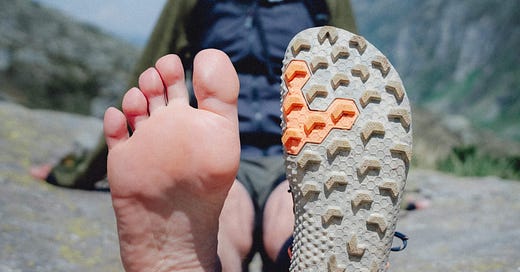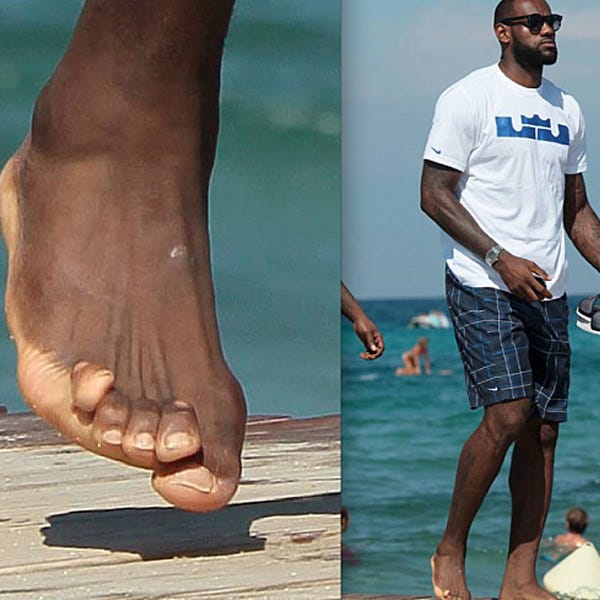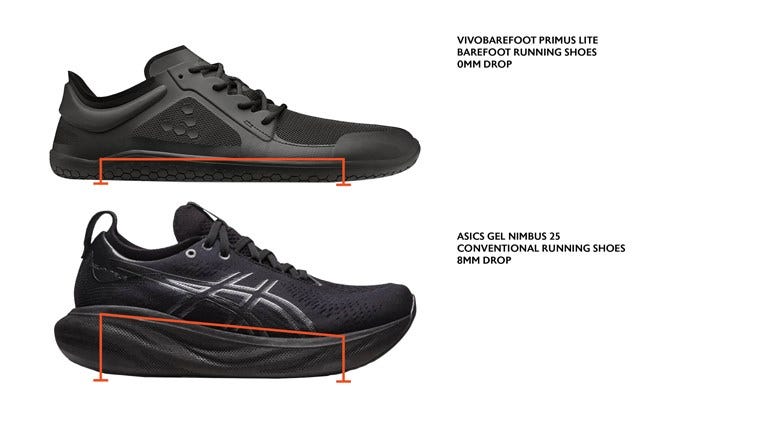Profile: Vivobarefoot Shoes
Reconnecting us to the planet, through our feet
We believe:
The closer people are to nature, the more they will protect it.
The natural world is the only real model of sustainability.
Barefoot footwear is regenerative to human health.
Does being closer to nature make us more likely to protect it?
How exactly is it regenerative to our overall health?
The minimalist, barefoot shoe category intrigues me. While the Nikes and Adidas have dominated athletic footwear for decades, here is this category that completely challenges that approach. Asking, why do we wrap our feet in padding and call it athletic footwear?
Shouldn’t our feet be trained just like any other part of our body?
Within the minimalist space, one company really stands out to me: Vivobarefoot. Why, because they take this idea further, beyond the functional. Through the idea that being closer to the ground means being closer to nature and that somehow that can lead to something bigger. Beyond stronger feet. Beyond sustainability. They call it regenerative footwear.
Here’s the story of a minimalist (i.e. barefoot) shoe company that takes the idea of reconnecting with nature to heart.
NOTE: full transparency, I own 4 pairs of Vivobarefoots and (2 trainers, 2 for casual). See down below for my thoughts.
OUR VISION is to reconnect people into the natural world and their natural potential by inspiring social and environmental change through regenerative business, communities and our footwear. And it starts with our feet. But we’re not there yet - not even close. That’s why this report is called UNFINISHED BUSINESS. - Vivobarefoot Annual Interim Report
We Are Vivobarefoot
Like others in the small but growing category of minimalist shoes, Vivo makes footwear purported to strengthen your foot’s connection to the ground through a wide toe box, and ultra-flexible, and thin soles that are lightweight; to both strengthen and make the feet more resilient.
But Vivo takes this philosophy much further.
The typical pair of sneakers generates 30 pounds of CO2 emissions—enough to keep a 100-watt light bulb on for a week.
Creating Regenerative Footwear
Vivo positions itself as an antidote to the footwear industry, particularly established leaders such as Nike or Adidas, which it feels are detrimental to our overall well-being in foot health and production practices.
Regenerative is the company’s ambition to create a product with a positive net effect for the planet as well as the individual, while growing a profitable business as a result.
The product delivers this through strengthening the feet as you move, promoted naturally in the design.
They’re also working towards net regenerative production through the entire supply-chain and product lifecycle.
This includes transitioning toward producing 100 percent recyclable, repairable, and/or biodegradable footwear. While actively exploring alternative manufacturing materials with reduced environmental impacts. Even going so far as to set up a program for refurbishing and reselling Vivo’s (a nod to their cobbler family roots) called Revivo.
We’re actively steering clear of key established industry practices. Our primary focus is on designing out waste entirely. We are committed to constructing truly circular solutions for all our products, aiming for a future where every piece of footwear we create can be recycled or is biodegradable. - Galahad Clark, founder and managing director
Headwinds
Vivobarefoot is a ‘big fish in a small pond’ right now. The minimalist footwear market is growing, but still quite niche. And part of the limitation is perceptual, as many of the early shoes weren’t that attractive.
That’s improved quite a bit, both from Vivo as well as other new players who have done a good job of mimicking more contemporary styles.
Marketing health benefits isn’t without risk. The purported benefits to foot health, strength, and resiliency
Even still, minimalist takes some getting used to. There is a breaking-in period necessary to avoid injury. And the thin sole (3-10MM) can be too much, particularly when you’ve been wearing traditional sneakers with lots of foam.
Premium. Within the category itself, Vivo’s tend to be the priciest. Starting around $120 (undiscounted) and going over $200.
Growing competition. As anyone who’s searched for barefoot shoes can attest, there are new entrants coming in who may push Vivo on price/style/performance.
Barefoot/minimalist isn’t for everyone. Which is perhaps the biggest limiting factor. There is a breaking-in period for certain (I can attest). For some, the lack of cushioning in the sole may be a dealbreaker. But for those who buy into the proposition, integrating footwear into their training can be a way to get into the category. Which could lead to adopting the more casual options into wear as well.
And this really has been my experience. I started off with Xero’s (a lower-priced competitor) as a way to test the waters. Then I switched over to Vivobarefoots and have since added in a couple of more casual shoes. The adoption has not been totally smooth, I definitely overdid it at first and suffered some sore feet as a result. But overall, it’s hard to imagine going back to traditional athletic shoes for me now.
I think it will be interesting to watch this company, to see if they can scale the minimalist category while pushing the industry to go beyond sustainability into something that’s actually regenerative.
“That’s the Vivo mission in a nutshell right there,” says Clark, Vivo’s CEO and Chief Ecosystem Officer. “People often ask, ‘What's the magic in these shoes?’ And it's just going back to the way we used to do things—with a bit of modern technology involved.” - Forbes
Vivobarefoot facts and figures:
minimalist running shoe company, based in the U.K.
founded in 2012 by seventh-generation cobblers (Clarks Shoes) Galahad Clark and Asher Clark with one goal in mind: to create footwear that brings us closer to nature
"The closer people are to nature, the more they will protect it…"Vivobarefoot footwear inspires a world with less padding and more feeling."
makes minimalist shoes aimed at providing the biomechanics and posture benefits associated with being barefoot
Revenue: £73MM in 22/23; Projected to grow to £86MM 23/24
Certified B Corp (in ‘20) demonstrating high social and environmental performance, legal commitment, and transparency with consumers, communities, and suppliers
Barefoot Shoes Market:
Minimalist (or barefoot) shoes are a small but growing niche in the footwear industry.
The purported benefits (shared by the category) are:
Strengthens the feet’ muscles, because the minimalism of the shoes allows for the feet to move more naturally utilizing all of the 27 muscles in our feet
Better balance and proprioception (awareness of the body position)
Encourages a midfoot strike (as opposed to heel) which reduces impact forces and its impact on joints (knees, hip, etc)
Improves your natural gate
The barefoot shoes market was valued at $471.09 million in 2021, and is estimated to reach $788.7 million by 2031, growing at a CAGR of 5.3% from 2022 to 2031
For comparison, the global footwear market was valued at $389.23 billion in 2022 and is projected to reach $568.54 billion by 2031, growing at a CAGR of 4.31% during 2023-2031.
North America held the largest market share in 2021, accounting for nearly two-fifths of the global market. The Asia-Pacific region is expected to witness the fastest CAGR of 5.6% from 2022 to 2031
Top competitors include:
Vibram - major player in rubber soles, its own shoe line (those 5 toe ones) generate an estimated 18MM euros in sales in ‘22
Lems Footwear - estimated somewhere between $1 to $5MM in revenue








